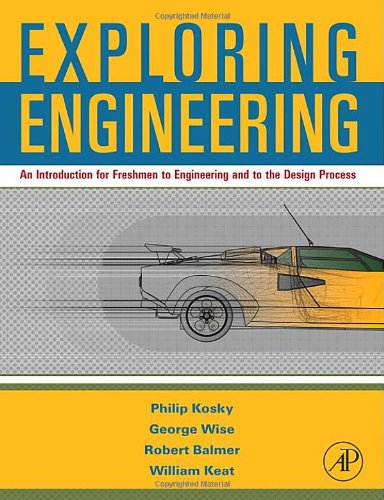Exploring Engineering An Introduction for Freshmen to Engineering and to the Design Process 1st Edition by George Wise, Philip Kosky, Robert Balmer, William Keat ISBN 9780080547183 0080547184
$50.00 Original price was: $50.00.$35.00Current price is: $35.00.
Exploring Engineering An Introduction for Freshmen to Engineering and to the Design Process 1st Edition by George Wise, Philip Kosky, Robert Balmer, William Keat – Ebook PDF Instant Download/Delivery: 9780080547183 ,0080547184
Full download Exploring Engineering An Introduction for Freshmen to Engineering and to the Design Process 1st Edition after payment

Product details:
ISBN 10: 0080547184
ISBN 13: 9780080547183
Author: George Wise, Philip Kosky, Robert Balmer, William Keat
Winner of the Best New Undergraduate Textbook Award from the Professional and Scholarly Publishing Division of the American Association of Publishers! Exploring Engineering was developed to meet the need for a better way to introduce incoming engineering students to the fundamental concepts at the heart of all engineering disciplines. It was also created to show students in a vivid way the great array of opportunities and possibilities of today’s engineering fields-from classical mechanical engineering to bioengineering and mechatronics. This is the first text to introduce nearly all of the major engineering areas, and to do so with a strong interdisciplinary case study approach. This approach better prepares and enables students to draw upon knowledge not only from their own particular field of expertise, but also from related or even distantly related engineering and technical and scientific fields, allowing them to become more versatile within their future employment.
Exploring Engineering is flexible enough to offer a variety of approaches to the introduction of modern engineering for new students, while still providing the most important essentials that hold all engineering disciplines together, particularly the mathematical, quantitative basis of engineering as well as the modern computer tools that make today’s engineering design so efficient and accurate.
* Introduces the fundamental physical, chemical, and material foundations for all engineering work, including motion, force, conservation of energy and matter
* Explains the workings of simple electrical circuits, computer logic, control and mechatronics, stress/strain diagrams, bioengineering, stoichiometry
* Offers applications of engineering ethics-using an extended case study metaphor: the modern automobile
* Provides simple data spreadsheets and other analytical “tools of the trade” to introduce students to the concepts of theoretical and of empirical engineering
* Presents the engineering design process using examples and assignments specifically aimed at helping to guide students and instructor through a hands-on design project
* A companion web site will offer a complete solutions manual and a number of suggested head-to-head competitions for a final design project
Exploring Engineering An Introduction for Freshmen to Engineering and to the Design Process 1st Edition Table of contents:
Part 1 Minds-on
1 What Engineers Do
Introduction
Learning Sections
Ethics
What Are Professional Ethics?
What You Should Expect from This Book
Summary
2 Key Elements of Engineering Analysis
The Elements of Engineering Analysis
The SI Unit System
Summary
Exercises
3 Solving Problems and Spreadsheet Analyses
The Need to Know How to Solve Method
Spreadsheet Analysis
Graphing in Spreadsheets
Summary
Exercises
4 Energy: Kinds, Conversion, and Conservation
Using Energy
Energy Is the Capability to Do Work
Kinds of Energy
Conversion
Conservation of Energy
Summary
Exercises
5 Chemical Energy of Fuels
Energy Conversion
Atoms, Molecules, and Chemical Reactions
The mol and the kmol
Stoichiometry
The Air-to-Fuel Ratio
The Heating Value of Hydrocarbon Fuels
The Heating Value of Fuels: The General Case
Summary
Exercises
6 The Automotive Drive Train
The Otto Cycle
Modeling the Power Output of the Otto Cycle
Derivation of Otto Cycle Power Output Equation
Motion
Gearing and Gear Ratios
Improving on the Otto Cycle
Summary
Exercises
7 Electrical Circuits
Introduction
Electrical Circuits
Resistance, Ohm’s Law, and the ‘‘Power Law’’
Series and Parallel Circuits
Switches
Summary
Exercises
8 Logic and Computers
Introduction
Analog Computers
From Analog to Digital Computing
Binary Logic
Truth Tables
Binary Arithmetic
Binary Codes
How Does a Computer Work?
Summary
Exercises
9 Control Systems Design and Mechatronics
Introduction
Modeling the Control System as a Block Diagram
Translating the Block Diagram into a Mathematical Model
Selecting a Control Strategy
Implementing the Chosen Strategy in Hardware
Drive-by-Wire
Summary
Exercises
10 Kinematics and Traffic Flow
Introduction
Distance, Speed, and Acceleration
The Speed Versus Time Diagram
Applying the Tool to the On-Ramp Problem
General Equations of Kinematics
The Highway Capacity Diagram
Summary
Exercises
11 Introduction to Materials Engineering
Introduction
Strength
Defining Materials Requirements
Materials Selection
Properties of Modern Materials
Summary
Exercises
12 Introduction to Bioengineering
Introduction
Biological Implications of Injuries to the Head
Why Collisions Can Kill
The Fracture Criterion
The Stress-Speed-Stopping Distance-Area Criterion
Criteria for Predicting Effects of Potential Accidents
Summary
Exercises
13 Introduction to Chemical Engineering
Introduction
Oil Refining
Oil Refineries
Process Engineering
Distillation
How Refinery Output Can Be Improved
Catalytic Conversion
Summary
Exercises
14 Cars of the Future—What Will They Be Like?
The Car Culture
Big Changes Ahead: Convergence
Automotive Electronics
Smart Automobile Safety Systems
Smart Tire Systems
Smart Exhaust Systems
Smart Drive-By-Wire Systems
Smart Highway Systems
Smart Traffic Systems
Smart Advanced Power Systems: Variable Displacement and Variable Valve Engines
Fuel Cell Systems
Enjoying the Ride—Smart Vehicle Entertainment Systems
How Do We Get There?
Looking Forward
Part 2 Hands-on
15 Introduction to Engineering Design
The Nature of Engineering Design
Hands-on Design Exercise: ‘‘The Tower’’
Benefits of a Hands-on Design Project
Qualities of a Good Designer
The Need for a Systematic Approach
The Steps in the Engineering Design Process
16 Two Ground Rules for Design
Ground Rule Number 1: Use a Design Notebook
Ground Rule Number 2: Team Effectively
17 Clarification of the Task
Problem Definition
List of Specifications
Design Milestone: Clarification of the Task
18 Generation of Alternative Concepts
Brainstorming
Concept Sketching
Hands-on Design Exercise: ‘‘The Tube’’
Research-Based Strategies for Promoting Creativity
Functional Decomposition for Complex Systems
Design Milestone: Generation of Alternatives
19 Evaluation of Alternatives and Selection of a Concept
Minimize the Information Content of the Design
Maintain the Independence of Functional Requirements
Design for Ease of Manufacture
Design for Robustness
Design for Adjustability
Hands-on Design Exercise: ‘‘Waste Ball’’
The Decision Matrix
Design Milestone: Evaluation of Alternatives
20 Detailed Design
Analysis
Experiments
Models
Detailed Drawings
Design Milestone: Detailed Design
21 Oral Design Defense
Design Milestone: Oral Design Defense
22 Manufacturing and Testing
Manufacturing and Testing Strategies
Materials
Joining Methods
Useful Hand Tools
Design Milestone: Design for Manufacture Assessment I
Design Milestone: Design for Manufacture Assessment II
23 Performance Evaluation
Individual Performance Testing
The Final Competition
Design Milestone: Individual Performance Testing
24 Design Report
Organization of the Report
Writing Guidelines
Design Milestone: Design Report
25 An Example of a Design Competition: “A Bridge Too Far”
Design Competition Example: ‘‘A Bridge Too Far’’
Design Milestone Solutions for ‘‘A Bridge Too Far’’
26 Closing Remarks on the Important Role of Design Projects
People also search for Exploring Engineering An Introduction for Freshmen to Engineering and to the Design Process 1st Edition:
freshman engineering
when is the engineering design process used
freshman engineering classes
in the engineering design process what is the first step
Tags:
George Wise,Philip Kosky,Robert Balmer,William Keat,Freshmen,Engineering



